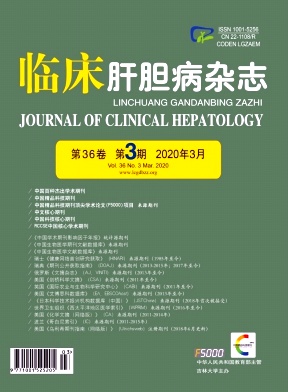|
[1] Infectious Diseases and Parasitology Branch,Hepatology Branch,Chinese Medical Association. Guideline:Prevention and treatment of viral hepatitis[J]. Chin J Intern Med,2001,40(1):62-68.(in Chinese)中华医学会传染病与寄生虫病学分会、肝病学分会.病毒性肝炎防治方案[J].中华内科杂志,2001,40(1):62-68.
|
|
[2] JANSEN C,MÖLLER P,MEYER C,et al. Increase in liver stiffness after transjugular intrahepatic portosystemic shunt is associated with inflammation and predicts mortality[J]. Hepatology,2018,67(4):1472-1484.
|
|
[3] GARCIA-TSAO G. Current management of the complications of cirrhosis and portal hypertension:Variceal hemorrhage,ascites,and spontaneous bacterial peritonitis[J]. Gastroenterology,2001,120(3):726-748.
|
|
[4] JENSEN DM. Endoscopic screening for varices in cirrhosis:Findings,implications,and outcomes[J]. Gastroenterology,2002,122(6):1620-1630.
|
|
[5] RIZZO L,ATTANASIO M,PINZONE MR,et al. A new sampling method for spleen stiffness measurement based on quantitative acoustic radiation force impulse elastography for noninvasive assessment of esophageal varices in newly diagnosed HCV-related cirrhosis[J]. Biomed Res Int,2014,2014:365982.
|
|
[6] ZHANG H,XU YQ. Association between serum ascites albumin gradient and esophagogastric variceal bleeding in patients with liver cirrhosis:A Meta-analysis[J]. J Clin Hepatol,2016,32(2):269-274.(in Chinese)张辉,徐有青.血清-腹水白蛋白梯度与肝硬化食管胃底静脉曲张破裂出血关系的Meta分析[J].临床肝胆病杂志,2016,32(2):269-274.
|
|
[7] YANG WW,YANG JH. Efficiency of platelet count in predicting occurrence risk of esophageal varices in patients with liver cirrhosis[J]. J Clin Med Prac,2018,22(19):101-105.(in Chinese)杨炜炜,杨建华.血小板计数预测肝硬化患者食管静脉曲张发生风险的探讨[J].实用临床医药杂志,2018,22(19):101-105.
|
|
[8] DENG H,QI XS,PENG Y,et al. Diagnostic accuracy of APRI,AAR,FIB-4,FI,and king scores for diagnosis of esophageal varices in liver cirrhosis:A retrospective study[J]. Med Sci Monit,2015,21:3961-3977.
|
|
[9] PEAGU R,SARARU R,NECULA A,et al. The role of spleen stiffness using ARFI in predicting esophageal varices in patients with hepatitis B and C virus-related cirrhosis[J]. Rom J Intern Med,2019.[Epub ahead of print]
|
|
[10] ZHANF DK,CHEN M,GAO YJ,et al. Clinical value of spleen acoustic radiation force impulse,aspartate aminotransferaseto-platelet ratio index,and aspartate aminotransferase/alanine aminotransferase ratio in predicting esophageal varices in patients with liver cirrhosis[J]. J Clin Hepatol,2018,34(3):508-512.(in Chinese)张大鹍,陈敏,皋月娟,等.脾脏ARFI弹性值与APRI及AAR指数对肝硬化食管静脉曲张的预测价值[J].临床肝胆病杂志,2018,34(3):508-512.
|
|
[11] ZHENG LP,WEN W,JIAN Y. The predictive value of transient elastography on upper gastrointestinal bleeding in patients with liver cirrhosis[J]. J Chengdu Med Coll,2018,13(1):85-88.(in Chinese)郑丽萍,文武,蹇贻.瞬时弹性成像技术对肝硬化患者上消化道出血的预测价值[J].成都医学院学报,2018,13(1):85-88.
|
|
[12] GHANY MG,DOO E. Assessment of liver fibrosis:Palpate,poke or pulse[J]. Hepatology,2005,42(4):759-761.
|
|
[13] ZHANG Y,DONG L,WANG H,et al. Correlation between liver stiffness and esophageal and gastric varices determined by acoustic radiation force impulse[J]. Chin J Ultrasound Med,2019,35(8):706-708.(in Chinese)张彦,董磊,王惠,等.声脉冲辐射力成像测定肝实质硬度与食管胃底静脉曲张相关性的初步研究[J].中国超声医学杂志,2019,35(8):706-708.
|
|
[14] DIETRICH CF,BAMBER J,BERZIGOTTI A,et al. EFSUMB guidelines and recommendations on the clinical use of liver ultrasound elastography,update 2017(long version)[J]. Ultraschall Med,2017,38(4):e16-e47.
|
|
[15] BOTA S,SPOREA I,SIRLI R,et al. Spleen assessment by Acoustic Radiation Force Impulse Elastography(ARFI)for prediction of liver cirrhosis and portal hypertension[J]. Med Ultrason,2010,12(3):213-217.
|
|
[16] KIM HY,JIN EH,KIM W,et al. The role of spleen stiffness in determining the severity and bleeding risk of esophageal varices in cirrhotic patients[J]. Medicine,2015,94(24):e1031.
|
|
[17] YANG XS,MENG FK,LYU Y. Feasibility of predicting esophageal varice and bleeding by spleen stiffness[J]. Beijing Med J,2017,39(12):1252-1254.(in Chinese)杨雪松,孟繁坤,吕元.肝硬度预测食管静脉曲张程度及出血风险的可行性研究[J].北京医学,2017,39(12):1252-1254.
|














 DownLoad:
DownLoad: